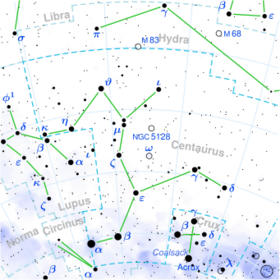Astronomy:Epsilon Centauri
| Observation data Equinox J2000.0]] (ICRS) | |
|---|---|
| Constellation | Centaurus |
| Right ascension | 13h 39m 53.25774s[1] |
| Declination | −53° 27′ 59.0081″[1] |
| Apparent magnitude (V) | +2.30[2] (2.29 - 2.31[3]) |
| Characteristics | |
| Spectral type | B1 III[4] |
| U−B color index | −0.92[2] |
| B−V color index | −0.22[2] |
| Variable type | β Cep[3] |
| Astrometry | |
| Radial velocity (Rv) | +3.0[5] km/s |
| Proper motion (μ) | RA: −15.30[1] mas/yr Dec.: −11.72[1] mas/yr |
| Parallax (π) | 7.63 ± 0.48[1] mas |
| Distance | 430 ± 30 ly (131 ± 8 pc) |
| Absolute magnitude (MV) | –3.9[6] |
| Details | |
| Mass | 11.60 ± 1.06[4] M☉ |
| Luminosity | 15,217[4] L☉ |
| Surface gravity (log g) | 3.68[6] cgs |
| Temperature | 24,000[4] K |
| Metallicity [Fe/H] | –0.14 ± 0.10[7] dex |
| Rotational velocity (v sin i) | 160[8] km/s |
| Age | 15.8 ± 5.7[9] Myr |
| Other designations | |
CP−52 6655, FK5 504, HD 118716, HIP 66657, HR 5132, SAO 241047. | |
| Database references | |
| SIMBAD | data |
Epsilon Centauri (ε Cen, ε Centauri) is a star in the southern constellation of Centaurus. It is one of the brightest stars in the constellation with a slightly variable apparent visual magnitude of +2.30. Parallax measurements put it at a distance of around 430 light-years (130 parsecs) from Earth.
In Chinese, 南門 (Nán Mén), meaning Southern Gate, refers to an asterism consisting of ε Centauri and α Centauri.[10] Consequently, the Chinese name for ε Centauri itself is 南門一 (Nán Mén yī, English: the First Star of Southern Gate.)[11]
ε Centauri is a massive star with nearly 12 times the mass of the Sun.[4] The spectrum matches a stellar classification of B1 III,[4] indicating this is an evolved giant star. It is radiating more than 15,000[4] times the luminosity of the Sun from its outer atmosphere at an effective temperature of 24,000 K,[4] giving it the blue-white hue of a B-type star.[13] This is classified as a Beta Cephei type variable star with a primary period of 0.16961 days (4 hours 4 minutes), completing 5.9 cycles per day.[7] During each cycle, the brightness of the star varies from apparent magnitude +2.29 to +2.31.
This star is a proper motion member of the Lower Centaurus–Crux sub-group in the Scorpius–Centaurus OB association, the nearest such association of co-moving massive stars to the Sun.[6] Epsilon Centauri is a relatively young star, with an age of around 16 million years.[9]
The IAU has not assigned a proper name to this star.[14]
References
- ↑ 1.0 1.1 1.2 1.3 1.4 van Leeuwen, F. (November 2007), "Validation of the new Hipparcos reduction", Astronomy and Astrophysics 474 (2): 653–664, doi:10.1051/0004-6361:20078357, Bibcode: 2007A&A...474..653V
- ↑ 2.0 2.1 2.2 Ducati, J. R. (2002). "VizieR Online Data Catalog: Catalogue of Stellar Photometry in Johnson's 11-color system". CDS/ADC Collection of Electronic Catalogues 2237: 0. Bibcode: 2002yCat.2237....0D.
- ↑ 3.0 3.1 Samus, N. N. et al. (2009). "VizieR Online Data Catalog: General Catalogue of Variable Stars (Samus+ 2007–2013)". VizieR On-line Data Catalog: B/GCVS. Originally Published in: 2009yCat....102025S 1: 02025. Bibcode: 2009yCat....102025S.
- ↑ 4.0 4.1 4.2 4.3 4.4 4.5 4.6 4.7 Hohle, M. M.; Neuhäuser, R.; Schutz, B. F. (April 2010), "Masses and luminosities of O- and B-type stars and red supergiants", Astronomische Nachrichten 331 (4): 349, doi:10.1002/asna.200911355, Bibcode: 2010AN....331..349H
- ↑ Evans, D. S. (June 20–24, 1966), "The Revision of the General Catalogue of Radial Velocities", in Batten, Alan Henry; Heard, John Frederick, Determination of Radial Velocities and their Applications, Proceedings from IAU Symposium no. 30, 30, University of Toronto: International Astronomical Union, p. 57, Bibcode: 1967IAUS...30...57E
- ↑ 6.0 6.1 6.2 de Geus, E. J.; de Zeeuw, P. T.; Lub, J. (June 1989), "Physical parameters of stars in the Scorpio-Centaurus OB association", Astronomy and Astrophysics 216 (1–2): 44–61, Bibcode: 1989A&A...216...44D
- ↑ 7.0 7.1 Daszyńska-Daszkiewicz, J.; Niemczura, E. (April 2005), "Metallicity of mono- and multiperiodic β Cephei stars", Astronomy and Astrophysics 433 (3): 1031–1035, doi:10.1051/0004-6361:20040397, Bibcode: 2005A&A...433.1031D
- ↑ Balona, L. A.; Dziembowski, W. A. (October 1999), "Excitation and visibility of high-degree modes in stars", Monthly Notices of the Royal Astronomical Society 309 (1): 221–232, doi:10.1046/j.1365-8711.1999.02821.x, Bibcode: 1999MNRAS.309..221B
- ↑ 9.0 9.1 Tetzlaff, N.; Neuhäuser, R.; Hohle, M. M. (January 2011), "A catalogue of young runaway Hipparcos stars within 3 kpc from the Sun", Monthly Notices of the Royal Astronomical Society 410 (1): 190–200, doi:10.1111/j.1365-2966.2010.17434.x, Bibcode: 2011MNRAS.410..190T
- ↑ (in Chinese) 中國星座神話, written by 陳久金. Published by 台灣書房出版有限公司, 2005, ISBN:978-986-7332-25-7.
- ↑ (in Chinese) AEEA (Activities of Exhibition and Education in Astronomy) 天文教育資訊網 2006 年 7 月 25 日
- ↑ Shobbrook, R. R. (1972). "Two new Beta Canis Majoris variables: epsilon Cen and delta Lup". Monthly Notices of the Royal Astronomical Society 157. doi:10.1093/mnras/157.1.5P. Bibcode: 1972MNRAS.157P...5S.
- ↑ "The Colour of Stars", Australia Telescope, Outreach and Education (Commonwealth Scientific and Industrial Research Organisation), December 21, 2004, http://outreach.atnf.csiro.au/education/senior/astrophysics/photometry_colour.html, retrieved 2012-01-16
- ↑ "Naming Stars". International Astronomical Union. https://www.iau.org/public/themes/naming_stars/.
 |



